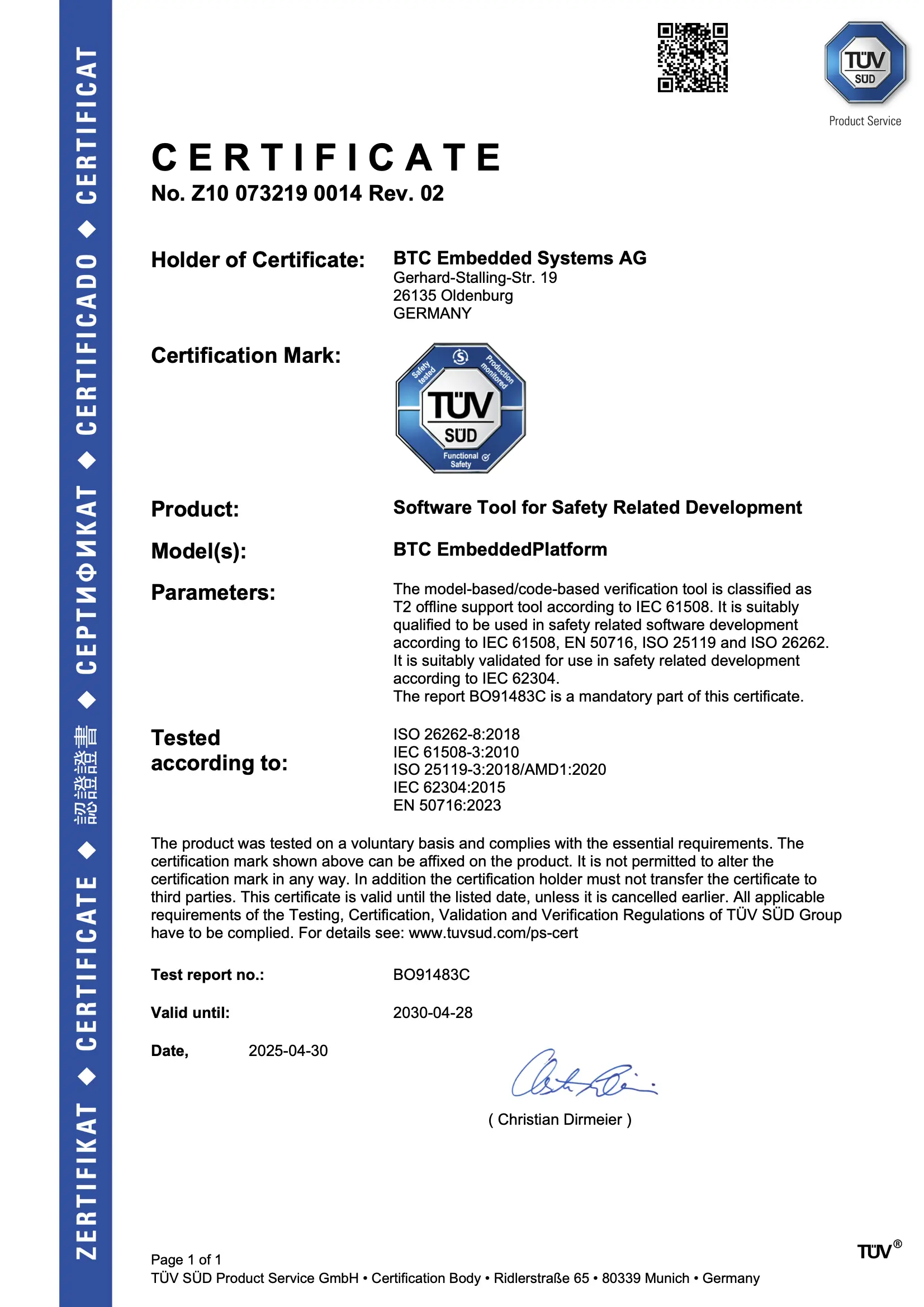Close
Compliant and certified
The increasing complexity of E/E Systems and shortened development cycles pose a challenge in selecting appropriate methods and tools.
The ISO 26262 standard provides recommendations for developing safety-related systems, including function classification based on safety criticality (ASIL levels) and state-of-the-art methods for development and testing.
It has become a de facto standard in the automotive industry for safety critical application development.
Part 6 of the ISO 26262 standard outlines the detailed procedures required for validating, verifying and confirming the safety of software systems in automotive contexts.
It provides methodologies for systematic and thorough evaluation of software designs and architectures. Key aspects include requirements-based testing, ensuring every function is tested for its intended output, and code coverage, which checks that every part of the code has been executed in tests.
Tool qualification is another essential element, ensuring that the tools used in the development process support the safety goals. Ensuring traceability of requirements, from their origins through to the implemented code and tests, is also a major focus.
BTC EmbeddedPlatform is a certified environment which addresses many requirements from the ISO 26262 standard for software verification & validation. Examples are:
Thanks to it’s tight integration with tools such as dSPACE TargetLink, Mathwork Simulink/Embedded Coder, IBM DOORS, Siemens Polarion or PTC Integrity, BTC EmbeddedPlatform is the perfect tool for an ISO 26262 compliant requirements-based test on model and code level
With our built-in Domain Checks features, you can easily address the ISO 26262 recommendations regarding Interface Test, Boundary Value Analysis and Equivalence Classes. And, with the unique test case generation capabilities of BTC EmbeddedTester, you can even automatically generate tests to reach all test goals or prove that some states are unreachable.
In BTC EmbeddedTester, code coverage is automatically calculated and updated in the background. Create, change, import, or delete a test case? The code coverage report has already been updated to reflect these changes.
We support different Processor-in-the-Loop environments to execute your code on the target platform and measure resource usage.
Back-to-back tests between model and code are highly recommend by the ISO 26262 standard. BTC EmbeddedPlatform manages this challenge automatically, with 100% completeness and 0% manual effort.
Thanks to our unique model checking technology you can obtain a mathematical proof that a given requirement cannot be violated by your software.
With a semi-formal or formal notation in BTC EmbeddedSpecifier, you can transform your safety requirements into a clear, unambiguous and machine-readable representation – improving their quality and making them much more valuable for the following steps in the development workflow.
BTC EmbeddedPlatform (incl. BTC EmbeddedTester BASE, BTC EmbeddedTester, BTC EmbeddedSpecifier and BTC EmbeddedValidator) has been certified by German TÜV Süd as fit for usage in safety critical software development projects.
The certificate addresses different standards including ISO 26262, IEC 61508-3:2010, ISO 25119, IEC 62304 as well as EN 50716.
For the automotive standard ISO 26262, we have been certified with the highest tool confidence level TCL and the certificate is valid for all ASIL levels including ASIL D.
We provide the certificate and the corresponding report to our customers free of charge upon request, which almost eliminates any effort for tool qualification measures on the customer side.

Sie möchten unsere Tools in Ihrer Entwicklungsumgebung testen? Gerne stellen wir Ihnen eine kostenfreie Evaluierungslizenz zur Verfügung., inkl. Kick-Off Trainings-Workshop und Support durch unser Team.
Sie haben Fragen oder Interesse an einer persönlichen Tool Demo? Nutzen Sie unten stehenden Link, um ein unverbindliches Meeting mit unserem Engineering Team zu buchen.
Sie möchten unsere Tools in Ihrer Entwicklungsumgebung testen? Gerne stellen wir Ihnen eine kostenfreie Evaluierungslizenz zur Verfügung., inkl. Kick-Off Trainings-Workshop und Support durch unser Team.
Sie haben Fragen oder Interesse an einer persönlichen Tool Demo? Nutzen Sie unten stehenden Link, um ein unverbindliches Meeting mit unserem Engineering Team zu buchen.
Smart test generation for an ISO 26262 certified and fully automated Back-to-Back Test
Wir entwickeln automatisierte und intelligente Test Lösungen, welche unseren Kunden weltweit dabei helfen, eine hohe Software Qualität im Einklang mit dem ISO 26262 Standard zu erreichen
Copyright © 2025 BTC Embedded Systems